A loud noise is heard in the distance. An explosion, two, three, four, five; the roar of detonations is approaching little by little, they are the deafening blows of whips hitting the ground. Thus begins the Carnival in Guadeloupe, a French-speaking island in the insular Caribbean.

Los látigos y sus explosiones abren el Mas o el déboulé, que no son un espectáculo con disfraces coloridos, adornos y coreografías, sino una caravana de personas sin camisa y con el cuerpo pintado de negro, que llegan cantando y marchando al son de los tambores, los caracoles y el chacha, un instrumento de percusión parecido a la maraca.
Antes de que comenzara a expandirse el Covid en Guadalupe, tuve la oportunidad de asistir a varios déboulés en Basse Terre, la capital de la Región, la mayoría de ellos protagonizados por la agrupación más grande de esta parte de la isla: Voukoum.
Es impresionante la energía que se desprende de ese inmenso mar humano, donde decenas, quizá cientos de integrantes pintados con una mezcla de melaza de caña y polvillo de carbón, vestidos con prendas rojas andan rítmicamente en el Mas.

La antesala al Mas, ese río de cuerpos y almas irreverentes, es una treintena de jóvenes con el pecho descubierto y con un short rojo que empuñan un látigo de entre dos y tres metros de largo, lo baten contra el suelo y el sonido retumba en los oídos de los espectadores. Son parte de los llamados “grupos de piel”.
En la isla, quien porta y hace sonar el látigo es llamado fouettard. Ellos se apropian de esta antigua arma de castigo, la manejan con destreza y le dan otro significado.
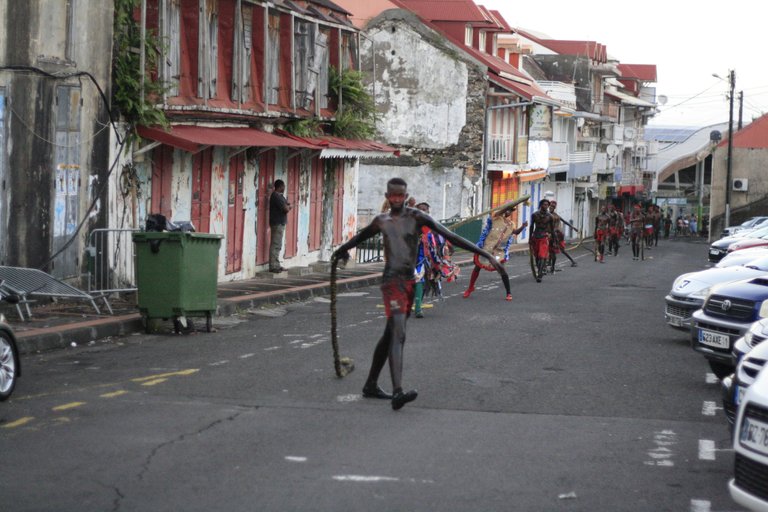
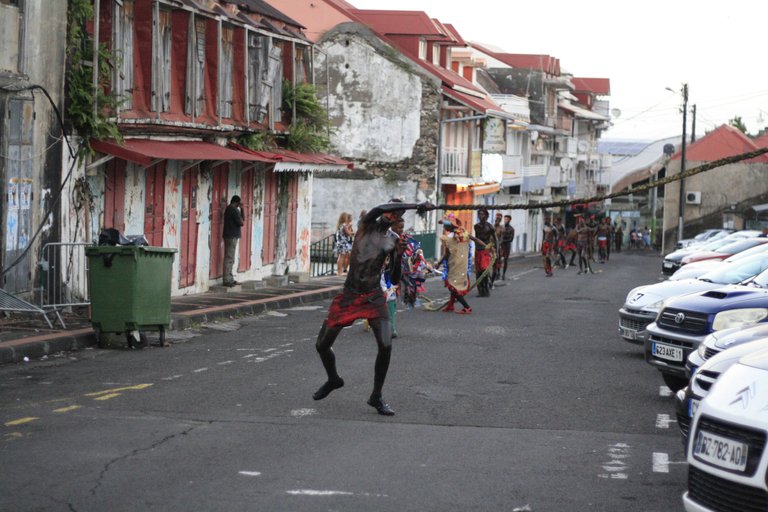


The whip in the Colony / El látigo en la Colonia
En francés, látigo se traduce fouet y durante la colonia lo usaron los esclavistas para castigar a los esclavizados por actos que los colonos consideraban faltas.
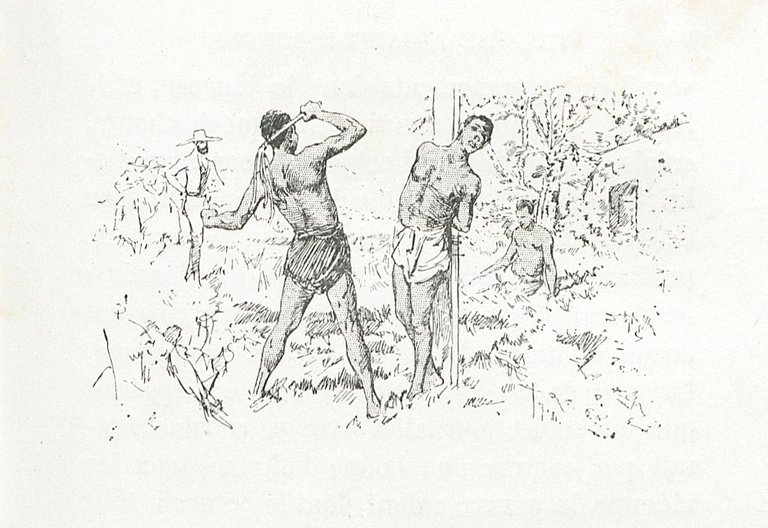
Fuente / Source : Thérèse à Saint-Domingue p.73
Le fouet est une partie intégrante du régime colonial, le fouet en est l’agent principal> ; le fouet en est l’âme. (Victor Schoelcher, 1948)
Debo citar unas elocuentes palabras del investigador Néba Fabrice Yale quien dice en su trabajo sobre la violencia en la esclavitud en las Antillas Francesas en el siglo XVIII, que en lugar de “latigar o azotar” a un esclavo, se decía “tallar” un esclavo y que el “dueño” era el acusador, juez y verdugo.
“Él podía ordenar tantos golpes como quería según ‘la gravedad de la falta’ cometida por el acusado y no había ninguna cuenta que rendir a nadie”, dice el autor.
What it is used for in carnival / Para qué se usa en el carnaval
El látigo no es exclusivo del Carnaval de Guadalupe, en el Callao, Venezuela; en Brasil e incluso en Puerto Príncipe, Haití, también son frecuentes los estallidos de látigos durante los desfiles.
Utilizado como instrumento de tortura por los colonos, para causar dolor y miedo, el látigo ha sido retomado como un símbolo dentro del carnaval guadalupeño por los “grupos de piel” y es colocado en el centro de las fiestas carnestolendas del Caribe para anunciar el colorido desfile lleno de ritmo y alegría.
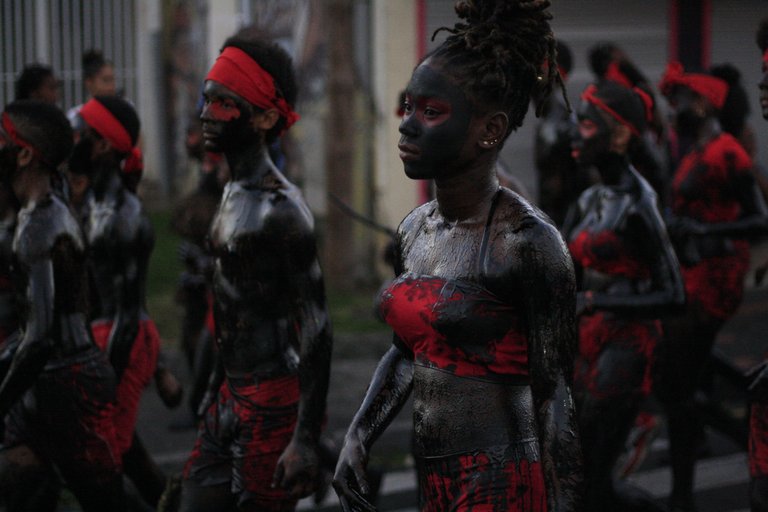
La función principal del látigo es ahuyentar a los espíritus malignos y abrir el camino al Mas, esa gran ola de gente que marcha al son de los tambores y los cánticos.
Tanto en la Grande-Terre como en la Basse-Terre, parte volcánica de la isla, desde muy pequeños los niños aprenden a hacer sonar los látigos, en las comparsas se ven pequeños de ocho, siete y hasta de seis años haciendo explotar contra el piso sus azotes.
Dentro de las asociaciones y grupos de carnaval donde se instruye a los jóvenes sobre su uso y se precisan algunas reglas como mantenerse separados entre ellos por unos tres metros de distancia, así como también respetar un espacio prudente con los espectadores del desfile para evitar accidentes.
The manufacture of the whip / La fabricación del látigo
El látigo tradicional se realiza con cuerdas náuticas o mecate que se encuentran en las tiendas de construcción o ferreterías, la cuerda se trenza y se amarran en su extremo otro cordón más fino llamado krash, hecho de fibras de un árbol llamado Karata.

El cordón de Karata es el que golpea el suelo y produce el ruido de explosión. Una vez amarradas las dos cuerdas se fijan los nudos con cinta adhesiva para sellarlos bien. A algunos látigos se les coloca un mango de madera pegado con cinta para asegurar el agarre del fouetard.

En Guadalupe son numerosos los fabricantes. Uno de ellos es Livio BOGDAN, un joven emprendedor que creó la marca Ti fwèta, una pequeña empresa de elaboración de látigos artesanales que además ofrece talleres para enseñar a usar el fouet. El propio Livio explica formidablemente cómo fabricar y cómo usar el látigo tradicional
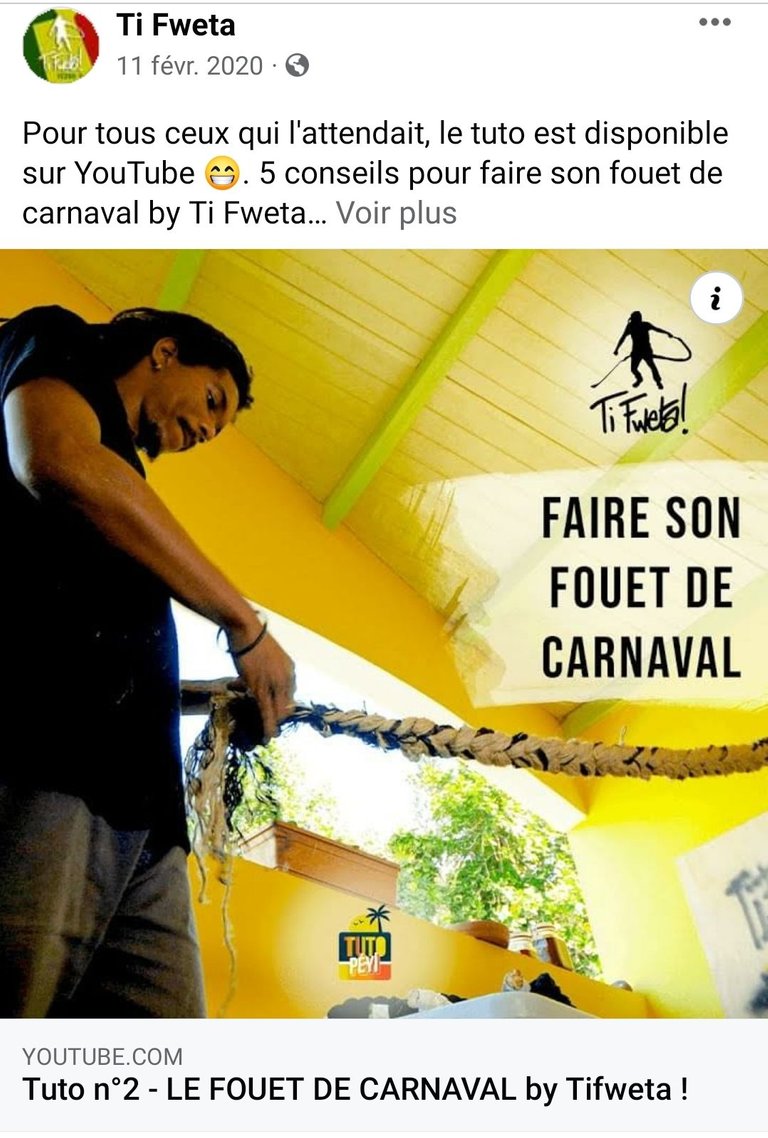
LE FOUET DE CARNAVAL by Tifweta !
Las fotografías son de mi autoría excepto las identificadas /
Photos by me excepting those identified
Traducido al inglés con https://www.deepl.com / Traslated to English with https://www.deepl.com
Congratulations, your post has been added to Pinmapple! 🎉🥳🍍
Did you know you have your own profile map?
And every post has their own map too!
Want to have your post on the map too?
Muy ilustrativo este relato, en general sabemos tan poco de las islas del Caribe y su cultura, la referencia que tenemos de ellas son más que todo imágenes de playas paradisíacas. Espero sigas compartiendo más material de esas tierras :)
Tienes razón, hay lindas playas pero mucho más que descubrir. El trabajo sigue, apenas comienza. Gracias por tu apoyo y tus palabras motivadoras.
Welcom to Hive @eltony!
It's quite amazing to see that the whip, which use to represent power is now a central part of an important event at Guadeloupe. Thank you for sharing such an interesting festival with us and pinning the first Guadeloupe post on Pinmapple.
In future, it is better if you can make your travel content directly on the haveyoubeenhere community https://peakd.com/c/hive-163772/created as OCD should only be used the general content that doesn't fit in any niche community.
Also, I have a post pinned on my blog which give some useful tips for newbies joining Hive. It is based on input from over 100 experienced Hive users and it will help you to start your Hive journey. Hope to continue see you around.
Daily Travel Digest #1478.
Become part of our travel community:
- Join our Discord
- Learn more about our travel application
Hiya, @LivingUKTaiwan here, just swinging by to let you know that this post made it into our Honorable Mentions in Your post has been manually curated by the @pinmapple team. If you like what we're doing, please drop by to check out all the rest of today's great posts and consider supporting other authors like yourself and us so we can keep the project going!Thank you @livinguktaiwan @pinmapple for your support and timely advice, it is very motivating to be in in your Honorable Mentions! I will certainly support this initiative and the other authors.
Very interesting. Love the pictures and the explanation of the cultural history :-)
Thank you for your appreciation and support!
Awesome post Antonio! Very interesting tradition, I didn´t know about it before. You took some very impressive pictures at the event too. I am glad your post attracted some big curators, well deserved and I bet also motivating for you ;) Keep up the great work!
@tipu curate
Upvoted 👌 (Mana: 43/83) Liquid rewards.
Thanks again for your words of support. It is very motivating to have the support of the curators. Now, let's keep working.
Jmmm, muy interesante, @gatubela necesita probar esos látigos caribeños 😼